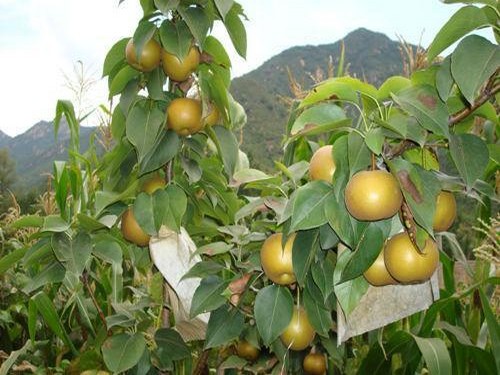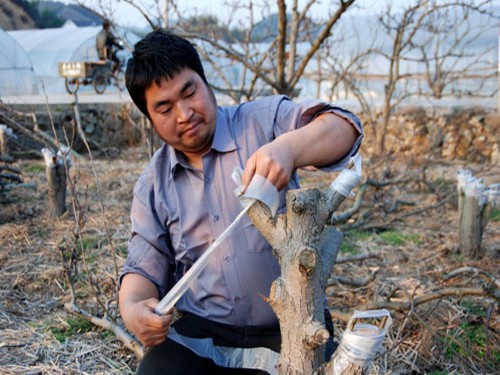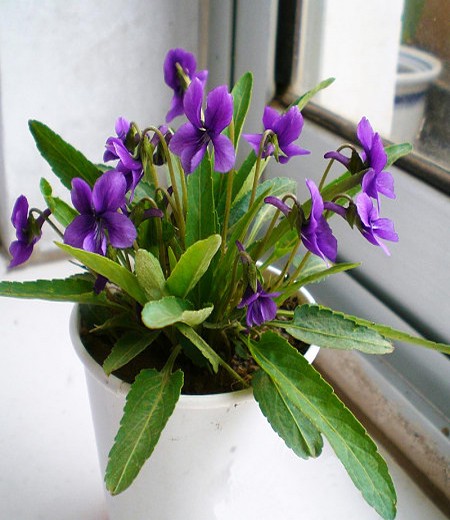Planting and Management techniques of Pear trees
In order to highlight its individual beauty, pear trees can be planted alone in the greening of the park. Generally choose open and open places, such as the edge of the lawn, the center of the flower bed, the sunny corner and both sides of the door, and so on. In spring, snow-white pear blossoms bloom; in autumn, rich pear fruit is covered with branches, making a beautiful scenery in the park. In addition, pear trees are planted by the park pool, by the hedge, under the rockery and beside the mound, accompanied by lawn or ground cover flowers. The use of pear trees in conjunction with other tree species not only enriches the landscape, but also attracts fruit-eating birds and increases ornamental fun.

The use of pear trees in the courtyard for the greening and beautification of palaces and courtyards has a history of more than 2000 years in China. In some famous landscape gardens, it is common to plant pear, orange, orange, peach, plum, plum and other fruit trees. Pear trees in addition to sweet fruit and elegant flowers, there is a unique tree-shaped beauty, suitable for residential viewing, suitable for courtyard cultivation. "Learning Garden Yu Shu" cloud: "dissolve the courtyard, how can there be such a king"; "Flower Mirror" cloud: "the rhyme of the pear, Li Zhijie, the garden is suitable for leisure, and the rising sun is kind." Pear trees are planted in court, they can watch flowers in spring, shade in summer, eat fruit in autumn, and enjoy the posture in winter.
Pear tree is one of the main fruit trees in China, in addition to raw food, it can also process canned pear wine, dried pear, preserved pear and so on. Pear trees bear fruit early, generally 2-3 years into production, 6 years can enter the full fruit period, full fruit period 667 square meters can be stable above 2000kg.
I. Establishment of Pear Orchard
Garden selection and planning can develop pear orchards regardless of flat land, hills, mountains and river beaches, but transportation, irrigation and other conditions should be considered. After the orchard address is selected, the orchard should be divided into several communities according to 2-10 hectares according to topography, topography, roads, channels and shelterbelts. In the hilly sloping land, the long side of the district is parallel to the contour as far as possible, which is beneficial to soil and water conservation and easy to manage. Pear trees can be planted from defoliation to pre-germination, and the planting density is determined according to different topography and land plots. Generally, the row spacing is 3m × 4m.
II. Planting techniques
Dig holes according to the distance between plants and rows, generally sandy soil, with a width of 80cm and a depth of 50-60cm, and rice holes with a width of 80cm and a depth of 40-50cm. First, add 30-40cm thick straw, branches or green manure, and add topsoil to tighten, then apply organic fertilizer (pig, cow manure) 50-80kg or pure chicken manure 10kg to mature, and add calcium magnesium phosphate fertilizer 1-2 kq (alkaline soil can be used calcium superphosphate) mixed with soil to make steamed bread. Before planting, it is necessary to cut off 2-3cm from the thick roots of pear seedlings to promote the occurrence of new roots and remove the film at the grafting site so as not to affect the growth of the trunk. When planting, the grafting interface should be exposed to the ground 5-10cm, firm rhizosphere soil, immediately irrigate enough water. Tuyere zone, need to set up a pillar to prevent lodging.
III. Management techniques of soil, fertilizer and water
1. Soil management
Deep ploughing and ripening of soil is a basic measure in the technology of increasing yield of pear trees. The time of deep ploughing and soil improvement is generally carried out after fruit harvest in autumn and before defoliation in winter. The methods include hole expansion, deep ploughing of the whole garden, interrow or interplant deep ploughing. The depth of deep turning is generally 30-40cm, and it can be turned every other year where possible, with a deep trench of about 0.8m in width on both sides of the original hole in 1, 3 and 5 years, and on the other side in 2, 4 and 6 years, combined with the application of base fertilizer. Generally, 100kg pear fruit needs at least organic fertilizer (pig, sheep stable manure) 100kg, and then mixed with 2.25kg phosphate fertilizer.
2. Fertilizer management
In addition to base fertilizer, in general, topdressing should be applied four times during the growing period, and the first post-anthesis fertilizer should be applied in mid-late April to promote branch and leaf growth, flower bud differentiation and fruit expansion, with a profit of 8-10 kg per mu; the second fruit expansion fertilizer should be applied twice from mid-May to early June, with a profit of 15-20 kg per mu. The third postharvest fertilizer was applied from late August to mid-September. Jiamei earned 10-15 kg per mu to increase leaf color, prolong leaf life and restore tree potential. In addition, combined with spraying Jiamei platinum for 2-3 times, extra-root topdressing can restore the nutrition level of the tree in time, and the effect is very obvious. In general, the amount of fertilizer applied to pear trees in the full fruit period should not be lower than the standard of jin fruit fertilizer. The set fertilizer is balanced according to the ratio of nitrogen: phosphorus: potassium 1: 0.5-0.7: 0.8-1.0, mainly Jiamei Yinglai and Nei potassium Germany.
3. Water management
Water is the limiting factor for the high quality and high yield of pear trees. If the water absorbed by the roots is not enough to supply foliar evaporation, the water in the fruit will be taken away by the leaves, resulting in thin, dull fruit, less pulp, dry cotton, voids and well-developed stone cells. Lack of moisture in June, too dry, will harden the calyx tip and form iron pears. When there was a serious water shortage in July, due to the poor development and even death of some cells in the pulp, the stone cells in the pulp increased significantly and the soft cell membrane was corked, resulting in the uneven surface of the fruit and the formation of "pimple" pear.
Fourth, equipped with pollination trees and three thinning techniques
Pear is a cross-pollinated tree species, and most varieties do not bear fruit by self-flowering, so pollination varieties that basically meet at flowering stage must be configured. The best ratio of main planting to pollination varieties is 2:1 or 1:1, and at least 3:1 or 4:1 is needed to achieve high and stable yield. The technique of "three thinning" is the period and method to correctly grasp the thinning of flower buds, buds and fruits.
1. Thinning flower buds
Combined with winter pruning to remove too many flower buds. In winter, flower buds should be thinned according to proportion, in principle, flower buds should be defined as leaf buds = 1:1, which is about 1 / 2 of the total flower amount, but attention should be paid to the number of flower buds formed in pear trees in the same year. In practice, the density of one flower bud per 15-18cm distance is suitable for backbone branches. Pay attention to sparse only flower buds and keep leaf buds.
2. Thinning flower buds
If the work of thinning flower buds is not carried out during winter pruning, it can be remedied by thinning flower buds before flowering, and the standard of bud thinning is generally about one bud according to 20cm. The principle of thinning buds: thinning weak and strong, sparse small and big, sparse axillary flower buds, sparse axillary flower buds, sparse flower buds, remove late budding buds, remove accessory buds.
3. Fruit thinning
It should be determined according to variety, tree potential, florescence and climate. If the number of flowers is large, the tree potential is weak, and the trees with high fruit setting rate should be thinned early, while the young and prosperous trees with few flowers should be thinned later or less. The weather should be sparse early in normal years, and vice versa. Generally speaking, each fruit should have 25-30 leaves, 1 fruit can be left in 1 fruit table in normal year, and 1-2 fruit can be left in 1 fruit platform for varieties with medium fruit shape.
4. Shaping and pruning
According to different varieties and different site conditions, the tree shape of pear tree is generally divided into open stratification, multi-trunk happy shape, multi-main branch round head shape and so on. Technical points of evacuation layered shaping and pruning:
(1) fixed trunk
The fixed dry height is generally 60-70cm, but it can also be 40cm. When drying, the cut should leave 7-8 full buds. If the height of the cut is not high enough, it can be cut short at 6-10cm from the ground so that it can be dried again in the second year.
(2) selection and cultivation of backbone branches.
In the winter of the first year after setting, the upright branch at the top was selected as the central stem and cultivated year by year. If the branch growth is weak, it can be re-cut properly. When the crown reaches 3.5m and has 5-7 fixed main branches, it can cover the top and fall the head. In order to promote the growth of the first layer main branch, the central trunk can be bent and raised when the central stem is extended, and the strong and weak can be used as the central trunk to extend the branch. after one year, if there are less than 3 branches in the base, the central stem can be re-pruned to promote the branching. in the second winter, the branches with suitable direction and angle were selected as the first layer main branch culture. When pruning, in order to keep the growth balance of the three main branches, the weak branches should be cut and put lightly, and then shrunk after being strong, so as to promote the development of strong branches. At the same time, we should pay attention to the opening angle of the main branch. if the angle is too small, 2-3-year-old pear trees can be pulled, supported, taken, hoisted, and trees more than 4 years old can use "inner bud pedal", head change and other methods.
(3) Culture and pruning of fruiting branches.
Results the configuration of the branch group should be dense at the top and bottom, dense at the outside, big at the bottom and small at the bottom. Branch group culture method: ① first retracted and then put: branches slowly flattened can quickly form flower buds or improve the fruit setting rate of long branches, and then retracted and cultured into branch group. Trees with exuberant growth can produce early and prolific crops. ② first truncated, then retracted, and then released: the current year-old branches were cut short below 17-20cm, prompting the branches close to the backbone branches to become strong and weak, straight and oblique, and then the remaining branches were slowly released or strong branches were flattened and released, and then retracted into large and medium-sized branches year by year. ③ transform auxiliary branches or temporary backbone branches: with the expansion of the crown, when there are too many large branches, the auxiliary branches or temporary backbone branches can be transformed into large and medium-sized branches. ④ short branch pruning method: the growing branch was heavily truncated at the latent bud at the base in winter, and if the shoot was still too strong in the next year, it was truncated below the 30cm of the new shoot, and then truncated again with the same method until a small and medium-sized branch group was formed. Fine pruning of big branch group plays an important role in improving yield and quality and preventing big and small years. First of all, the main measure is to control the amount of flower buds, so that the adaptation effect between tree potential and yield is more obvious than that of thinning flowers and fruits.
Prevention and control of diseases and insect pests
1. Scab
It mainly occurs in sepals, fruits, leaves, petioles, shoots and buds. Symptoms: yellowish round small disease spot at the initial stage, black mildew in the later stage. Most of the leaves occur on the back of the leaves, along the veins of the leaves, and cause early defoliation in severe cases. Most of the fruits occurred in the young fruit stage, the growth of the injured young fruit stopped, gradually showed cork cracking, and caused the deformity of the young fruit, which was the most serious in the season of Rain Water (April-May).
[prevention and control methods]
① eliminated the source of overwintering bacteria. Remove fallen leaves, fruit and pruned branches and scrape bark in winter and burn them centrally.
② chemical control. Spray 5 before budding. Be stone-sulfur mixture, spray 25% carbendazim 500x liquid in Xiehua 3 / 4, shoot growth period in mid-May, spray 75% chlorothalonil liquid or other disease control agents once in fruit growth period in mid-June.
2. Pear rust
It mainly harms leaves, new shoots and young fruits. The needle-like yellow disease spot appeared on the leaf at first, and gradually expanded into orange-yellow round spot. in the later stage, the leaf was sunken on the front and protruded on the back, and a cluster of gray-yellow hairs grew, and the symptoms on the fruit were the same as those on the leaf. The disease occurs in fruit trees once a year, and the peak of the disease is from the first half of April to the first ten days of May.
[control methods] there should be no cypress trees such as pine and cypress, dragon cypress and so on in the area within 5km. Spray 200 times Bordeaux liquid before blossom, 15% trimethoprim or 1000 times Lingfu solution after Xiehua, 2-3 times in a row.
3. Pear heart borer
To harm the tender shoots, fruits and pear fruits of peaches. Five generations a year, the young fruit decay from the top of the fruit and near the calyx depression to the core, there are insect dung in the pulp, dry rot and black around the wormhole. The first generation mainly harms the tender shoots of peach from April to May, and then one generation occurs every month, mainly harming pear fruit, and the peak of pear fruit from August to September.
[control methods] Peach and pear orchards were sprayed on peach trees in early April and early and middle May. In the middle and late June and mid-July, the larvae of each generation were protected by spraying on the pear tree. The medicament can use 20% permethrin, 20% hyperosmotic monocrotophos 8-1000 times solution, or 5% dimethrin 5000 times solution, 20% pyrethrin 4000-5000 times solution, the effect is good.
4. Pear aphid
To harm the leaves. The damaged leaves were rolled into a tube, which was the most serious from April to May and propagated in weeds after late May. Winged aphids fly to mulberry trees again in October, overwintering in the cracks of pear buds in winter, more than 20 generations a year.
[control methods] attention should be paid to the control of pears after flowering. 1000 times of imidacloprid or 1500 times of pure wettable powder can be used.
Time: 2019-05-25 Click:
- Prev

Pear Grafting Technique
Pear tree is a traditional cultivated fruit tree in China. As far as 3000 years ago, the working people had domesticated wild pear trees and bred many pear varieties. Pear tree not only has economic value, but also has important ecological value and ornamental value. It can also be widely used in urban and rural landscaping.
- Next

How to plant domesticated purple flowers
In spring, there is a kind of inconspicuous flower on the ground, called purple flower, which does not choose soil, has strong adaptability and is easy to breed. Although it is not as expensive as a rose, purple flowers carry a lot of value. The flowering stage of purple flower is early and concentrated, and the plant is low, neat and compact.
Related
- Fuxing push coffee new agricultural production and marketing class: lack of small-scale processing plants
- Jujube rice field leisure farm deep ploughing Yilan for five years to create a space for organic food and play
- Nongyu Farm-A trial of organic papaya for brave women with advanced technology
- Four points for attention in the prevention and control of diseases and insect pests of edible fungi
- How to add nutrient solution to Edible Fungi
- Is there any good way to control edible fungus mites?
- Open Inoculation Technology of Edible Fungi
- Is there any clever way to use fertilizer for edible fungus in winter?
- What agents are used to kill the pathogens of edible fungi in the mushroom shed?
- Rapid drying of Edible Fungi

